What Size Nail For Deck With 2x6
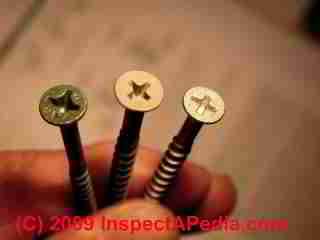 Wood Framing Fasteners
Wood Framing Fasteners
Stud, Joist, Porch, Deck Board Screws & Nails
- POST a QUESTION or Annotate about structural fasteners, nails, bolts, or hidden fasteners for wood framing of buildings, decks & porches
InspectAPedia tolerates no conflicts of involvement. Nosotros have no relationship with advertisers, products, or services discussed at this website.
Choices of deck structural & flooring fasteners:
types of structure screws, nails, bolts to use when edifice a deck, railing, or exterior stair.
This article explains critical safe-construction details for decks and porches, including avoiding deck or porch collapse and unsafe deck stairs and railings.
We also provide an ARTICLE Index for this topic, or you can endeavor the page top or lesser SEARCH BOX as a quick way to observe information y'all demand.
Guide to Selecting the Proper Deck & Porch Structural Fasteners, Screws, Nails, Lags, Bolts
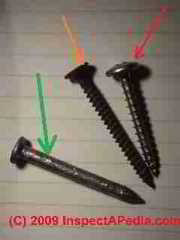 The Correct & The Wrong Fastener Nails & Screws Used for Joist Hangers, Framing Ties, Framing Connector Plates
The Correct & The Wrong Fastener Nails & Screws Used for Joist Hangers, Framing Ties, Framing Connector Plates
Article Contents
- FRAMING FASTENERS, NAILS, SCREWS - CONTENTS: Structural Fasteners, screws, nails, bolts, hidden fasteners used for wood frame construction, including deck & porch construction
- Choices of deck nails, screws, coated fasteners, and subconscious fasteners for deck floor, railing, joist hanger, and other construction connectors
- Using drywall screws, roofing nails, hanger tabs, or other improper fasteners for wood framing
- What are the Primal Forces that Concur Nails & Screws in Wood as Structural Connectors?
- New Woods Preservatives and Their Corrosion Effects on Deck Nails, Screws, Connectors & Fasteners
- Typical[7] Blast Schedule for Metal Framing Connectors - Joist Hangers
- Stainless Steel Nails & Screws for Decks in Salt-Exposed or Moisture/Humid Climates; aluminum deck nails?
- Subconscious Deck Fasteners for Deck Boards; Screws for Utilise with Deck Floors - Decking
- Deck Joist & Beam Sizing Tables & A Quick Rule of Thumb for Sizing Joists
- Examples of poor or improperly made structural connections that pb to collapse of Decks and Porches
Our photograph, above left, shows three fasteners we take found used with steel joist hangers. This photo shows the heads of each of these fasteners.

Because the new forest preservatives ACQ (alkaline copper quat) and copper azole contain significantly more than copper than the older CCA-treated lumber, they are estimated to exist two to 4 times more than corrosive to metals and galvanized coatings than the CCA they are replacing.
- Hot dipped galvanized nails: At bottom of our photo higher up and shown fully nailed at left is a 1.5" long hot-dipped galvanized nail fabricated by Simpson, and discussed but beneath. This is a proper fastener to employ with galvanized steel joist hangers.
Other specialty fasteners used for joist hangers, mail connectors and like connector plates and ties are provided by a variety of manufacturers including special ability-tool operated fasteners used with special Paslode™ or Senco™ mailers.
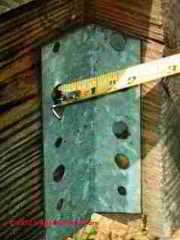
- Covering nails used for Joist Hangers? No. Use of roofing nails equally structural fasteners is unsafe and violates edifice codes.
Watch out: do not use a roofing nail for fastening framing connectors. The curt length of galvanized covering nails and their easy availability tempts some inexperienced framers to use them for structural fasteners.
Do not do this. This is an improper fastener that will fail and risks catastrophic deck collapse.
In fact the terminal hammer blows that seat a roofing nail onto a steel framing connector tin can weaken or even completely sever the connexion between the nail head and the nail shank,leaving no structural connexion at all!

- Drywall screws: In the middle of our photo higher up is a 1.v" drywall spiral. These screws are tempting to use because they are available, like shooting fish in a barrel to install, practice not require drilling.
Spotter out: drywall screws are not structural fasteners. We have inspected decks constructed entirely using interior drywall screws for both decking and for structural connections and joist hangers.
Do not do this. This is an improper fastener that will fail and risks catastrophic deck collapse.
Comparing Joist Hanger Nails, Drywell Screws, Joist Hanger Tabs, & Utility "Construction" Screws - which are acceptable?

Stainless steel utility screws: At the top of our photo (red pointer at left) is a one 1/iv" stainless steel screw used by a contractor to secure joist hangers when building the deck shown at the top of DECK & PORCH Construction.
The orangish arrow points to a drywall screw, and the green arrow to the proper smash for steel structural fasteners, a Simpson Strong-Necktie N10 DHDG 1 ane/ii" hot dipped galvanized "joist hanger" blast.
Lookout man out: Although the stainless steel screw (red arrow) screw is as well made by a company that makes structural fasteners, a quick look at the company'south specifications for this screw revealed that the manufacturer specifically advised that this screw was not a structural fastener and should not be used with steel framing connectors.
What most those little "Tabs" on Joist Hangers - tin can I simply blast those in and skip the joist hanger nails?
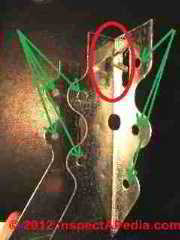
Watch out: the curt answer is "no".
The locating tab (red oval in our photograph at left) is intended to temporarily hold the joist hanger in identify (just hammer information technology in) while you reach down into your boom apron to grasp a handful of joist hanger nails.
The tab is not a structural fastener and cannot exist relied-on for that purpose.
Find that the Tamlyn joist hanger shown in our photo provides for two joist hanger nails that will exist hammered into the sides of the sides of the joist (ii from each side), and three that volition exist nailed into the header or rim joist or ledger board (three at each side).
Our greenish arrows remind us of where we should see nails in the installed joist hanger.
Key Forces that Agree Nails & Screws in Forest as Structural Connectors
Nailing Stainless steel, galvanized, as well as proprietary-coating surfaced construction screws for utilize with treated lumber are available and of course are fine if used as recommended. Simply not the 2 screws shown in this photograph and removed from decks nosotros inspected.
In the deck we inspected and where these improper screws had been installed, the contractor agreed to remove the screws and to replace them using the proper fasteners instead.
Lookout out: when removing and replacing wood framing fasteners: Even then nosotros were not quite sure that the deck was safely framed. Why?
The pigsty left by removing the incorrect screws amounts to a "pre-drilled" opening in the ledger board or axle to which the joist hangers were later nailed. The holding power of a nail (or screw) fastener, the strength that keeps the structure safely together, involves:
Shear forcefulness - force beyond the diameter of the fastener. The shear force resistance of a blast or screw is a function of the thickness and composition of the spiral textile.
Withdrawal forcefulness - the force that keeps the fastener from pulling out of the forest.
Spiral fasteners take improved withdrawal force resistance because their threads cut into the surrounding wood.
Nails depend on friction for their resistance to withdrawal forcefulness - the "tightness" with which the wood member presses against the sides of the nail. When we nail into a pre-existing hole in a structural member, this withdrawal force may be compromised, specially depending on the bore of the hole but too depending on the wood species and its dryness also as the smoothness of the shank of the nail itself.
at DECK COLLAPSE Instance Study nosotros describe a serious deck collapse that occurred when the deck ledger pulled abroad from the edifice. T
he deck ledger discussed in that study had been nailed to the rim joist through siding, using too-small common nails, missing bolt connectors or other proper ties.
The ledger, and thus the whole deck was unable to resist withdrawal forces.
The deck pulled away from the building and collapsed. Other mistakes exacerbated the failure and fall. People were injured.
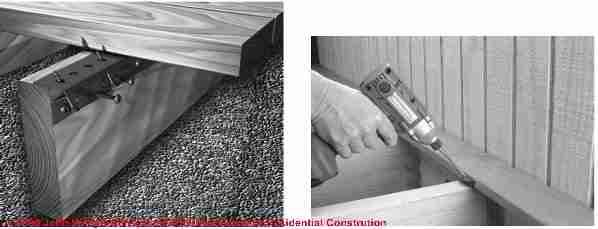
Position of the fastener also is significant in withdrawal force of both nails and screws.
For the identical size, weight, and number of fasteners, a boom that is horizontal with respect to the components it is supporting has less withdrawal force imposed on it (in general) than one which is nailed up: nailing a board straight "upwardly" to a ceiling joist or rafter imposes more withdrawal force on the nails than nailing a board horizontally onto studs in a structural wall.
Length of the fastener is also significant. The fastener must be long enough to penetrate the structural woods members deeply enough to provide sufficient resistance against withdrawal.
(That'due south why roof shingle nailing specifications, presuming the installation is over 3/iv" plywood, look the tip of the roofing nail to beetle through the iii/4" decking - to be certain that we have at least 3/4" of woods around the full-bore shank of the roofing nail.)
Toe-nailing is particularly effective at improving the withdrawal force of nails used in framing construction.
The crossing of nails past i another when nailed from opposing sides of a joist or stud forms a stronger connexion than the same number of nails would provide if all placed on the same bending simply just in one side of the framing fellow member.
Most treatment manufacturers recommend that fasteners and hardware in contact with the new treated wood exist stainless-steel, heavily coated hot-dipped galvanized, or proprietary fasteners tested and approved by the manufacturer.
New Woods Preservatives and Their Corrosion Effects on Deck Nails, Screws, Connectors & Fasteners
Hot-Dipped Galvanized Nails for Treated Lumber Decking
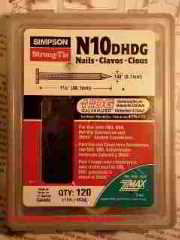
These deck structure nails, such as the joist hanger nails shown in our photo above, accept three times as much zinc blanket as standard G60 connectors. Examples of G185 coatings include Simpson's Z-Max or USP Connector'due south Triple-Zinc. Best Practices Guide to Residential Construction explains:
When using lumber treated with ACQ or copper azole, employ hot-dipped galvanized fasteners that see ASTM A153 with a minimum of 2 ounces of zinc coating per square foot.
Some galvanized nails intended for deck construction are marketed as "doublehot- dipped."
Connectors, flashings, and other hardware in contact with treated wood should meet ASTM A653, Class G185 (1.85 ounces of zinc per square human foot of metallic surface). Galvanized fasteners may stain redwood and cedar, however.
Typical[seven] Nail Schedule for Metal Framing Connectors - Joist Hangers
| Nominal Wood Joist Size | Nails into Abutting Header (through the connector) (10d 1 i/2" joist hanger nails) | Nails into Joist (through the connector) (10d 1 1/2" joist hanger nails) |
| Unmarried Joists | ||
| 2x4 | 4 | 2 |
| 2x6 | half-dozen | iv |
| 2x8 | 8 | half-dozen |
| 2x10 | 10 | 6 |
| 2x12 | ten | half-dozen |
| 2x14 | 10 | 6 |
Typical[7] Nail Schedule for Metallic Framing Connectors - Joist Hangers - Built-up Beams
| Nominal Wood Joist Size | Nominal Thickness (every bit number of 2x's making up the header or axle) | Nails into Abutting Header (through the connector - sum of both sides) (10d i 1/ii" joist hanger nails) | Nails into Joist (through the connector, sum of both sides) (10d ane one/ii" joist hanger nails) |
| Built-up headers & beams: double, triple, quad or custom thickness, joist & truss hangers | |||
| 2x6 | 2 - 2x6'southward (3" thick) | viii | iv |
| 2x8 | two - 2x8'due south (iii" thick) | 12 | 6 |
| 2x10 | 2 - 2x10'south (iii" thick) | fourteen | eight |
| 2x12 | ii - 2x12'southward (3" thick) | fourteen | viii |
| 2x14 | 2 - 2x14's (3" thick) | fourteen | viii |
| 4x8 | 4x8 (3-1/2" thick) | 12 | half dozen |
| 4x10 | 4x10 (iii-1/ii" thick) | fourteen | 8 |
| 2x10 | 3 - 2x10'southward | xiv | viii |
| 2x10 | 4 - 2x10's | half-dozen (review needed) | four (review needed) |
References
- Simpson Stiff-tie DECK Connectedness and FASTENING GUIDE [PDF] (2019) Recommendations for the construction of building-lawmaking-compliant decks, Simpson Potent Tie®, retrieved 2020/11/23, original source: https://www2.strongtie.com/catalog_order.asp?site=SST where yous can download any of a large collection of reference documents, catalogs, and product guides from Simpson Potent-Necktie.
- Simpson Potent-tie FASTENING SYSTEMS Catalog & TECHNICAL GUIDE [PDF] (2019) , Simpson Stiff Tie®, retrieved 2020/eleven/23, original source: https://www2.strongtie.com/catalog_order.asp?site=SST where yous can download any of a large collection of reference documents, catalogs, and product guides from Simpson Stiff-Tie.
- Simpson Strong-tie C-F-2019TECHSUP [PDF] is a 164-page technical document featuring engineering data, illustrations, diagrams and tables for structural fasteners featured in the C-F-2019 Fastening Systems Catalog listed only above.
- Simpson Strong-necktie WOOD CONSTRUCTION CONNECTORS [PDF] (2020) , Simpson Strong Necktie®, retrieved 2020/11/23, original source: https://www2.strongtie.com/catalog_order.asp?site=SST where you tin download whatsoever of a large collection of reference documents, catalogs, and product guides from Simpson Strong-Necktie.
Stainless Steel Nails & Screws for Decks in Salt-Exposed or Wet/Humid Climates
In very wet or humid climates, or in areas subject area to salt-water spray or deicing salts, stainless steel is the best pick. Stainless steel is also recommended for tropical hardwoods, which tend to cause staining with coated nails.
Both types 304 and 316 stainless steel have been tested for use with the new wood preservatives ACQ and copper azole. Type 304 is suitable for to a higher place- footing applications. Blazon 316 is recommended in areas discipline to common salt or common salt h2o.
Picket out: Never use stainless steel in contact with galvanized steel, as the galvanized coating volition quickly corrode. Where fasteners such as nails, bolts, or lags are in contact with metal connectors, use the same metal for both components.
Proprietary Deck Screw or Nail Coatings
 Many decking screws sold in home centers have newer proprietary ceramic and epoxy coatings over an electro galvanized cadre.
Many decking screws sold in home centers have newer proprietary ceramic and epoxy coatings over an electro galvanized cadre.
Originally developed for use with CCA-treated lumber, many accept now been tested and approved for use with ACQ and copper azole.
Our photo, left, shows ii proprietary-blanket coated structural screws used for decks; the right-hand most spiral is hot-dip galvanized. This photo shows these two i/ii" screws from the side view.
Grip-Rite Fas'ners® produces "PrimeGuard Ten" outside screws that apply a coating approved for exterior use with all types of treated lumber.
Prudential produces galvanized exterior deck screws such equally the one shown at the right in our photo, above.
These screws are warranted "for equally long as you ain your dwelling house" and are rated for use in untreated or CCA force per unit area treated woods in residential structures.
If using one of these fastener types, make sure that information technology is recommended by the manufacturer for the specific type of decking being installed.
Aluminum Deck Nails
Best Practices Guide to Residential Construction continues:
Sentinel out: Practise not use aluminum fasteners, connectors, or flashings in contact with force per unit area-treated woods. The copper-based waterborne preservatives will cause corrosion and premature failure.
Besides meet PRESERVATIVE TREATED LUMBER.
Subconscious Deck Fasteners for Deck Boards
Over time, confront-nailed deck fasteners may loosen, stain the forest decking, or lead to splitting and water penetration. Particularly with college-end decking materials, such equally tropical hardwoods, more customers are opting for hidden fastening systems.
See Deck & Porch Products, Manufacturers.
Each system is proprietary, and some crave proprietary tools supplied by the fastener manufacturer.
Some suppliers of hardwood decking recommend a specific fastener for their product and may sell the fasteners forth with the decking. There are two types of systems.
1, such as Deckmaster® (Grabber Construction Products), uses a right-bending bracket that fastens to the tops of the joists and screws into the underside of the decking. These are easiest to install if the installer has access from beneath the deck.
The other type uses individual fasteners that fit between adjacent decking planks and spiral down into the top of the joist. These typically adhere to the edges of the decking planks with clips or prongs.
A variation on this type called Eb-Ty (Blue Heron Enterprises) fits into slots cut into the edges of adjacent deck boards with a plate jointer (meet Figure four-five below).

The biggest business with hidden deck fasteners is whether they are strong enough to resist the trend of deck boards to warp or twist.
For that reason, they are best used with premium decking products, which are dimensionally stable. Tropical hardwoods and blended decking are good candidates for hidden fasteners.
-- Adapted with permission from Best Practices Guide to Residential Construction.
Guide to Selecting the Proper Deck or Porch Floor Decking Fasteners
Whether using nails or screws, make sure to choose a product that is up to the job both structurally and aesthetically. In general, screws are more expensive to buy and install, merely often they make for a neater job with fewer callbacks due to boards popping up.
Structure adhesives specially formulated for treated woods may exist used in conjunction with nails or screws.
Nails for Utilise with Deck Floors - Decking
If the decking is to be nailed, use either screw-, twist-, or band-shanked nails to resist pullout. When using pressure-treated wood, the fasteners should be either hot- dipped galvanized, coming together ASTM A153, or stainless steel Type 304 or higher
See NEW PRESERVSTIVES & CORROSION above
and see PRESERVATIVE TREATED LUMBER.
Galvanized nails sometimes cause discoloration with redwood, cedar, and tropical hardwoods, so stainless steel is a safer choice with these materials. Aluminum nails are as well an option for redwood or cedar, but they should non be used with force per unit area-treated forest.
The bigger the head, the better the concord-down ability.
At a minimum, apply a casing nail, preferably a common. Some manufacturers sell special decking nails with a head size in between the two. For 5/4" decking utilise a 10d (three-inch) nail. For thicker decking use a 16d (3 1/2") boom.
Deck Joist & Beam Sizing Tables & A Quick Dominion of Thumb for Sizing Joists
Spans, sizes and spacings for deck joists and deck beams are discussed in item
at FRAMING TABLES, SPANS for DECKS
and are listed in Tabular array four-7
and Table 4-8.
Decking Spans for deck flooring are shown in the Table 4-4 below.
[Click to enlarge any image or table]
[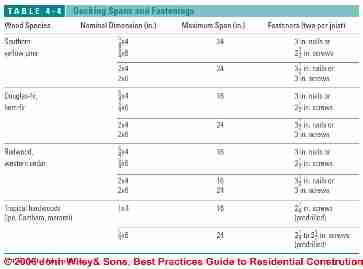
Screws for Use with Deck Floors - Decking
Power-driven screws are more expensive and a little slower to install, but they are the all-time choice since they do a better job of holding downward the decking and are more hands removed for repairs.
For treated wood, utilize either hot-dipped galvanized screws that meet ASTM A153, stainless-steel multipurpose screws, or specialty decking screws with proprietary coatings tested and approved for use with the new types of wood treatments.
Multipurpose screws have a thicker shank and courser thread than drywall screws, giving them greater force and better holding ability. Some specialized decking screws likewise have cut nubs under the head for self-countersinking in woods.
Others have special concave "pancake" heads for blended decking. The composite-decking screws leave a crisp hole in the decking surface without the typical pucker of backlog material (mushrooming) around the screw head (see Figure 4-4 below).
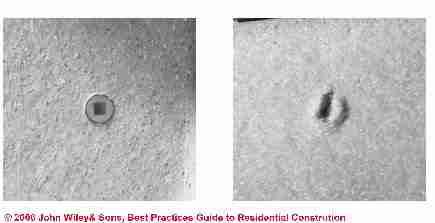
In addition to Phillips-head screws, decking screws come up with square-drive and star-bulldoze heads that let higher torque driving without stripping the head.
Also see DECK Collapse Case Study (collapse of a new code-approved deck)
and DECK FLASHING LEAKS, ROT Case Study for an example of an older deck with rot and plummet due to improper structure and missing building flashing.
-- Adapted with permission from Best Practices Guide to Residential Construction.
Hidden Deck Screws
"Hidden" deck screws are structural fasteners for connecting decking that use proprietary screws or backer connectors that do non announced on the deck surface. See:
- FastenMaster, [Cortex® hidden fastening system] Tel: 1-800-518-3569, Email: info@fastenmaster.com, Website: fastenmaster.com
- Hohmann & Barnard, Inc, produces a huge range of structural ties and anchors, including for masonry repair and restoration, rock anchors, rebar positioners, [Fly Nut two-Seal™ Tie, wing nut veneer ballast seals air barriers], Offices in viii U.S. cities, including H&B New York 30 Rasons Court, Hauppauge, NY 11788 (P) 631-234-0600, (F) 631-234-0683, Toll: 800-645-0616, Website: world wide web.h-b.com
Basic building framing information is plant at FRAMING AGE, SIZE, SPACING, TYPES.
Spans, sizes and spacings for deck joists and deck beams are discussed in detail
at FRAMING TABLES, SPANS for DECKS
and are shown in Table 4-7 and Table 4-8.
Tips for Removing Coated Deck Fasteners & Screws
Reader Question: how can I remove the screws securing PVC deck railings from my deck?
I am trying to remove PVC deck rails from my deck using an 18 volt power commuter and can't budge virtually of the fasteners which are coated 2 ½ #eight. In a lot of cases the heads have broken off, but most will not budge even with the driver ready in the highest torque. Whatsoever ideas? - J.R. 30 June 2015
Reply:
Pause them or cutting them through with a hacksaw bract and reciprocating saw.
Reader follow-up:
Thanks ... unfortunately the screws are inside a PVC deck railing bracket and the bottom brackets are 36 inches down a PVC mail service sleeve! I even tied buying a speed out kit that "removes any damaged screws in 10 seconds" and that didn't piece of work.
 Respond:
Respond:
When I've had this trouble I've cleaved the screws by driving a apartment bar through the interfaced connection.
The screws will snap nicely.
If at that place is a risk of damaging the deck runway or other PVC deck components with the flat bar, use ii thin flat bars, bulldoze them betwixt the joined segments, then hammer a tertiary apartment bar or even a flooring chisel between them to break the fastener without gouging the PVC material.
The grey chisel near the acme right in the photograph shown at above left is a flooring chisel that can work in this application
If you lot can get a couple of thin flatbars and a thin common cold chisel and IF your situation gives you a place to bulldoze them, the fasteners volition usually snap chop-chop. I've used this method to remove deck boards when the freakin' screws all stripped when I tried to unscrew them.
An alternative that works with wood joists and beams into which screws are driven is to apply a long thin punch and drive the screws downwardly into the underlying fellow member.
Drilling the screw heads off will besides sometimes allow pry upward of the attached member from the secured-to fellow member. And so the screw remains that projects up from the secured-to member can be clipped or snapped off. But I'd avoid drilling through PVC plastic runway in areas where a slipping drill bit makes an ugly mess.
...
Continue reading at DECK FASTENER CHOICES or select a topic from the closely-related manufactures beneath, or meet the consummate Commodity INDEX.
Or see these FRAMING FASTENERS, NAILS, SCREWS FAQs - questions & answers posted originally on this page
Or run across these
Recommended Manufactures
- CONNECTORS, FASTENERS, TIES
- DECK Building & CARPENTRY TOOLS
- DECK CONSTRUCTION Best PRACTICES - home
- DECK Pattern & BUILD - dwelling
- DECK FASTENER CHOICES
- DECK FRAMING TABLES, SPANS
- FRAMING Harm, INSPECTION, REPAIR - home
- FRAMING FASTENERS, NAILS, SCREWS - best construction practices.
- FRAMING CONNECTORS & JOIST HANGERS - best construction practices.
- HURRICANE TIE Down CONNECTORS & FASTENERS - in framing connectors, are screws ok to utilize instead of nails? Yes in some cases.
- STAIR STRINGER to FRAMING CONNECTORS
- TOE NAILED FRAMING CONNECTIONS - traditional framing without steel connectors
Suggested citation for this web page
FRAMING FASTENERS, NAILS, SCREWS at InspectApedia.com - online encyclopedia of building & environmental inspection, testing, diagnosis, repair, & trouble prevention advice.
Or see this
INDEX to RELATED Articles: Article Index to BUILDING DECKS & PORCHES
Or use the SEARCH BOX found beneath to Ask a Question or Search InspectApedia
Or see
Alphabetize to RELATED Articles: Article INDEX to BUILDING STRUCTURES
Or utilize the SEARCH BOX plant below to Ask a Question or Search InspectApedia
...
Inquire a Question or Search InspectApedia
Effort the search box only beneath, or if you prefer, post a question or annotate in the Comments box below and we will reply promptly.
Search the InspectApedia website
Note: advent of your Comment below may be delayed: if your comment contains an image, web link, or text that looks to the software as if it might be a web link, your posting will appear after it has been approved by a moderator. Apologies for the delay. Our Comment Box is provided by Countable Web Productions countable.ca
Technical Reviewers & References
Click to Bear witness or Hide Citations & References
Publisher InspectApedia.com - Daniel Friedman
Source: https://inspectapedia.com/BestPractices/Deck_Construction_Fasteners.php
Posted by: robersonquidents.blogspot.com

0 Response to "What Size Nail For Deck With 2x6"
Post a Comment